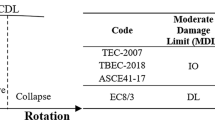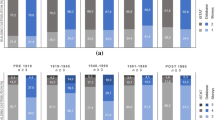Abstract
The simplified mechanical method POST (PushOver on Shear Type models) for seismic vulnerability assessment of RC buildings is used in this study to derive damage scenarios for a database of 7597 RC buildings subjected to the 2009 L’Aquila earthquake. POST allows the evaluation of fragility curves through the determination of the non-linear static response of RC buildings in closed form, assuming the hypothesis of shear type behaviour, and considering the influence of infill panels both in the derivation of structural response and in assessment of building damage, which is defined according to the European Macroseismic Scale EMS-98. The aim of the present study is to provide a much more significant and reliable validation of the methodology, thanks to a much wider database compared to previous studies, and based on a different application of the methodology, i.e. at building class-level instead of single building-level. To this aim, the main geometrical-typological characteristics of the analysed buildings (number of storeys, age of construction, building area) have been statistically characterized based on data collected from post-earthquake AeDES survey forms, considering both the variability of each single parameter and the correlation that exists between one parameter and the other. This also allows to analyse the effectiveness of the adopted analytical procedure in predicting the general trends of observed damage with these parameters, showing a good agreement between observed and predicted trends. The overall predicted damage scenarios are compared with the corresponding observed ones, collected from AeDES survey forms, highlighting, again, a good agreement. Finally, the assumed mechanical interpretation of damage classification of EMS-98 is validated through the comparison between the distributions of damage to vertical structures and infill panels and the corresponding observed post-earthquake damage data.















Similar content being viewed by others
References
Aslani H, Miranda E (2005) Probabilistic earthquake loss estimation and loss disaggregation in buildings. Diss. Stanford University
Asteris PG, Antoniou ST, Sophianopoulos DS, Chrysostomou CZ (2011) Mathematical macromodeling of infilled frames: state of the art. J Struct Eng 137(12):1508–1517
Baggio C, Bernardini A, Colozza R, Coppari S, Corazza L, Della Bella M, Di Pasquale G, Dolce M, Goretti A, Martinelli A, Orsini G, Papa F, Zuccaro G (2007) Field manual for post-earthquake damage and safety assessment and short term countermeasures. Translation from Italian: Goretti A., Rota M., JRC Scientific and Technical Reports, EUR 22868 EN-2007
Bernardini A, Lagomarsino S, Mannella A, Martinelli A, Milano L, Parodi S, Troffaes M (2010) Forecasting seismic damage scenarios of residential buildings from rough inventories: a case-study in the Abruzzo Region (Italy). Proc Inst Mech Eng Part O J Risk Reliab 224(4):279–296
Berry M, Eberhard MO (2003) Performance models for flexural damage in reinforced concrete columns. PEER Report 2003/18, Pacific Engineering Research Center, University of California, Berkeley, CA, USA
Bird JF, Bommer JJ, Bray JD, Sancio R, Spence RJS (2004) Comparing loss estimation with observed damage in a zone of ground failure: a study of the 1999 Kocaeli earthquake in Turkey. Bull Earthq Eng 2(3):329–360
Biskinis D, Fardis MN (2010) Deformations at flexural yielding of members with continuous or lap-spliced bars. Struct Concr 11(3):128–138
Calvi GM, Pinho R, Magenes G, Bommer JJ, Restrepo-Veléz LF, Crowley H (2006) The development of seismic vulnerability assessment methodologies for variable geographical scales over the past 30 years. ISET J Earthq Technol 43(3):75–104
Chrysostomou CZ, Asteris PG (2012) On the in-plane properties and capacities of infilled frames. Eng Struct 41:385–402
Circolare del Ministero dei Lavori Pubblici. n. 617 del 2/2/2009. Istruzioni per l’applicazione delle “Nuove norme tecniche per le costruzioni” di cui al DM 14 gennaio 2008 (in Italian)
C.N.I.—Consiglio Nazionale degli Ingegneri (2014) I costi dei terremoti in Italia, Centro Studi Consiglio Nazionale Ingegneri, cr 470. Roma (in italian)
Colangelo F (2013) Drift-sensitive non-structural damage to masonry-infilled reinforced concrete frames designed to Eurocode 8. Bull Earthq Eng 11(6):2151–2176
Crisafulli FJ, Carr AJ, Park R (2000) Analytical modelling of infilled frames structures—a general review. Bull N Z Soc Earthq Eng 33(1):30–47
D’Ayala D, Paganoni S (2011) Assessment and analysis of damage in L’Aquila historic city centre after 6th April 2009. Bull Earthq Eng 9(1):81–104
D’Ayala D, Meslem A, Vamvatsikos D, Porter K, Rossetto T, Silva V (2015) Guidelines for analytical vulnerability assessment of low/mid-rise buildings, vulnerability global component project. https://doi.org/10.13117/gem.vuln-mod.tr2014.12
De Luca F, Verderame GM, Gómez-Martínez F, Pérez-García A (2014) The structural role played by masonry infills on RC building performances after the 2011 Lorca. Spain, earthquake. Bull Earthq Eng 12(5):1999–2026
De Luca F, Verderame GM, Manfredi G (2015) Analytical versus observational fragilities: the case of Pettino (L’Aquila) damage data database. Bull Earthq Eng 13(4):1161–1181
Decanini LD, Liberatore L, Mollaioli F (2014) Strength and stiffness reduction factors for infilled frames with openings. Earthq Eng Eng Vib 13:437–454
Decreto Ministeriale n 40 del 3/3/1975, “Norme tecniche per le costruzioni in zone sismiche” (in Italian)
Decreto Ministeriale del 14/1/2008: Approvazione delle nuove norme tecniche per le costruzioni. G.U. n. 29 del 4/2/2008 (in Italian)
Del Gaudio C, Ricci P, Verderame GM, Manfredi G (2015) Development and urban-scale application of a simplified method for seismic fragility assessment of RC buildings. Eng Struct 91:40–57
Del Gaudio C, De Martino G, Di Ludovico M, Manfredi G, Prota A, Ricci P, Verderame GM (2016a) Empirical fragility curves from damage data on RC buildings after the 2009 L’Aquila earthquake. Bull Earthq Eng. https://doi.org/10.1007/s10518-016-0026-1
Del Gaudio C, Ricci P, Verderame GM, Manfredi G (2016b) Observed and predicted earthquake damage scenarios: the case study of Pettino (L’Aquila) after the 6th April 2009 event. Bull Earthq Eng. https://doi.org/10.1007/s10518-016-9919-2
Del Gaudio C, Ricci P, Verderame GM, Manfredi G (2017) Urban-scale seismic fragility assessment of RC buildings subjected to L’Aquila earthquake. Soil Dyn Earthq Eng 96:49–63
Dolce M, Goretti A (2015) Building damage assessment after the 2009 Abruzzi earthquake. Bull Earthq Eng 13:2241. https://doi.org/10.1007/s10518-015-9723-4
Dolce M, Moroni C (2005) La valutazione della vulnerabilità e del rischio sismico degli edifici pubblici mediante le procedure VC (vulnerabilità c.a.) e VM (vulnerabilità muratura), Atti del Dipartimento di Strutture, Geotecnica, Geologia applicata all’ingegneria, N. 4/2005 (in Italian)
ECS-it (2015) Software sulla evoluzione della classificazione sismica Italiana (evolution of the Italian seismic classification). http://www.reluis.it/
Erdik M, Şeşetyan K, Demircioğlu MB, Hancılar U, Zülfikar C (2011) Rapid earthquake loss assessment after damaging earthquakes. Soil Dyn Earthq Eng 31(2):247–266
Fardis MN (eds) (1996) Experimental and numerical investigations on the seismic response of RC infilled frames and recommendations for code provisions. ECOEST/PREC 8, Rep. No. 6. LNEC. Lisbon
Fiorini E, Borzi B, Iaccino R (2012) Real time damage scenario: case study for the L’Aquila earthquake. In: Proceedings of the 15th world conference on earthquake engineering, September 24–28, Lisbon, Portugal. Paper 3707
Grünthal G (1998) Cahiers du Centre Européen de Géodynamique et de Séismologie: volume 15—European Macroseismic Scale 1998. European Center for Geodynamics and Seismology, Luxembourg
Haselton CB, Liel AB, Taylor-Lange S, Deierlein GG (2008) Beam-column element model calibrated for predicting flexural response leading to global collapse of RC frame buildings. PEER Report 2007/03, Pacific Engineering Research Center, University of California, Berkeley, CA, USA
INGV-DPC S1. Progetto S1. Proseguimento della assistenza al DPC per il completamento e la gestione della mappa di pericolosità sismica prevista dall’Ordinanza PCM 3274 e progettazione di ulteriori sviluppi. Istituto Nazionale di Geofisica e Vulcanologia—Dipartimento della Protezione Civile; 2007. http://esse1.mi.ingv.it (in Italian)
Kakaletsis DJ, Karayannis CG (2009) Experimental investigation of infilled reinforced concrete frames with openings. ACI Struct J 106(2):132–141
Lagomarsino S, Giovinazzi S (2006) Macroseismic and mechanical models for the vulnerability and damage assessment of current buildings. Bull Earthq Eng 4(4):415–443
Liel A, Lynch K (2012) Vulnerability of reinforced-concrete-frame buildings and their occupants in the 2009 L’Aquila, Italy, earthquake. Nat Hazards Rev 13:11–23
Maio R, Georgios T (2016). Seismic fragility curves for the European building stock: review and evaluation of analytical fragility curves. EUR 27635 EN. https://doi.org/10.2788/586263
Masi A, Vona M (2009) Estimation of the in-situ concrete strength: provisions of the European and Italian seismic codes and possible improvements. In: Cosenza E (ed) Eurocode 8 perspectives from the Italian standpoint workshop. Doppiavoce, Naples, Italy, 2009. ISBN 978-88-89972-16-8, pp. 67–77
Masi A, Chiauzzi L, Santarsiero G, Manfredi V, Biondi S, Spacone E, Del Gaudio C, Ricci P, Manfredi G, Verderame GM (2017) Seismic response of RC buildings during the Mw 6.0 August 24, 2016 Central Italy earthquake: the Amatrice case study. Bull Earthq Eng. https://doi.org/10.1007/s10518-017-0277-5
Mollaioli F, Bazzurro P, Bruno S, De Sortis A (2009) Influenza della modellazione strutturale sulla risposta sismica di telai in cemento armato tamponati. Atti del XIII convegno ANIDIS “L’ingegneria sismica in Italia”, Bologna, Italy, June 28-July 2. Paper SM10-3 (in Italian)
OPCM 3274 (2005) Ordinanza del Presidente del Consiglio dei Ministri del 20 marzo 2003 “Primi elementi in materia di criteri generali per la classificazione sismica del territorio nazionale e di normative tecniche per le costruzioni in zona sismica”, revisione del 12/1/2005 a cura del Gruppo di Lavoro istituito dal Dipartimento di Protezione Civile
Panagiotakos TB, Fardis MN, (1996) Seismic response of infilled RC frames structures. In: Proceedings of the 11th world conference on earthquake engineering, Acapulco, México. Paper No. 225
Regio Decreto Legge n. 431 del 13/3/1927 (1927) Norme tecniche ed igieniche di edilizia per le località colpite dai terremoti. G.U. n. 82 dell’8/4/1927 (in Italian)
Ricci P (2010) Seismic vulnerability of existing RC buildings. PhD thesis, University of Naples Federico II, Naples, Italy
Ricci P, De Luca F, Verderame GM (2011) 6th April 2009 L’Aquila earthquake, Italy: reinforced concrete building performance. Bull Earthq Eng 9(1):285–305
Rossetto T, Ioannou I, Grant DN (2013) Existing empirical fragility and vulnerability functions: Compendium and guide for selection, GEM Technical Report 2013-X, GEM Foundation, Pavia, Italy
Rossetto T, Ioannou I, Grant DN, Maqsood T (2014) Guidelines for empirical vulnerability assessment, GEM Technical Report 2014-X, GEM Foundation, Pavia, Italy
Rota M, Penna A, Strobbia CL (2008) Processing Italian damage data to derive typological fragility curves. Soil Dyn Earthq Eng 28(10–11):933–947
Sabetta F, Speranza E, Borzi B, Faravelli M (2013) Scenari di danno empirici e analitici a confronto con recenti terremoti italiani. Atti del 32° Convegno Nazionale GNGTS (Gruppo Nazionale di Geofisica della Terra Solida), November 19–21, Trieste, Italy. Volume 2, pp. 136–141 (in Italian)
Sezen H, Moehle JP (2004) Shear strength model for lightly reinforced concrete columns. J Struct Eng 130(11):1692–1703
Sieberg A (1930) Geologie der Erdbeben. Handbuch der Geophysik 2(4):552–555
Tertulliani A, Arcoraci L, Berardi M, Bernardini F, Camassi R, Castellano C, Del Mese S, Ercolani E, Graziani L, Leschiutta I, Rossi A, Vecchi M (2011) An application of EMS98 in a medium-sized city: the case of L’Aquila (Central Italy) after the April 6, 2009 Mw 6.3 earthquake. Bull Earthq Eng 9(1):67–80
Vamvatsikos D, Cornell CA (2006) Direct estimation of the seismic demand and capacity of oscillators with multi-linear static pushovers through IDA. Earthq Eng Struct Dyn 35(9):1097–1117
Verderame GM, Manfredi G, Frunzio G (2001) Le proprietà meccaniche dei calcestruzzi impiegati nelle strutture in cemento armato realizzate negli anni ‘60. Atti del X congresso nazionale ANIDIS ‘‘L’ingegneria Sismica in Italia”, Potenza-Matera, Italy, September 9–13 (in Italian)
Verderame GM, Polese M, Mariniello C, Manfredi G (2010) A simulated design procedure for the assessment of seismic capacity of existing reinforced concrete buildings. Adv Eng Softw 41(2):323–335
Verderame GM, Ricci P, Esposito M, Manfredi G, (2012) STIL v1.0—Software per la caratterizzazione delle proprietà meccaniche degli acciai da c.a. tra il 1950 e il 2000. ReLUIS. http://www.reluis.it/
Vorechovsky M, Novak D (2009) Correlation control in small-sample Monte Carlo type simulations I: a simulated annealing approach. Probab Eng Mech 24(3):452–462
Acknowledgements
This work was developed under the financial support of METROPOLIS (Grant No. B58F12000460005) (“Metodologie e tecnologie integrate e sostenibili per l’adattamento e la sicurezza di sistemi urbani”—Programma Operativo Nazionale—Ricerca e Competitività 2007–2013) and “ReLUIS-DPC 2014–2018—Linea Cemento Armato” (Grant No. E56D16000670005), funded by the Italian Department of Civil Protection (DPC). These supports are gratefully acknowledged.
Author information
Authors and Affiliations
Corresponding author
Rights and permissions
About this article
Cite this article
Del Gaudio, C., Ricci, P. & Verderame, G.M. A class-oriented mechanical approach for seismic damage assessment of RC buildings subjected to the 2009 L’Aquila earthquake. Bull Earthquake Eng 16, 4581–4605 (2018). https://doi.org/10.1007/s10518-018-0365-1
Received:
Accepted:
Published:
Issue Date:
DOI: https://doi.org/10.1007/s10518-018-0365-1




